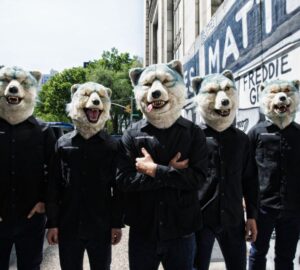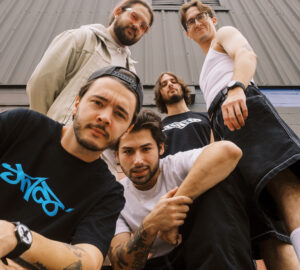Progressive metal quintet Wilderun re-released their stunning third album Veil Of Imagination last month, following their worldwide signing to Century Media Records earlier this year. Veil Of Imagination sees the band take a slightly different approach to creating music, resulting in an eclectic and multi-layered release that had us hooked from the first listen. We caught up with Evan Anderson Berry (vocals, guitar, piano) and Dan Müller (bass, synth, orchestrations) to delve deeper and discover more about the tracks that make up Veil Of Imagination…
The Unimaginable Zero Summer
Evan: This was perhaps the most concisely written track on the album. Excluding the intro, which was sorta written on its own, everything from when the band enters until the band exits, I wrote pretty much exclusively on guitar in the course of a few days. This is retrospectively pretty interesting, considering some of the shorter, simpler songs on Veil… were written over a longer period of time, with more changes and edits along the way. I think that’s why this song flows so well and holds tension particularly well. It was one of the most “flow-state” writing sessions I had for this album. It’s also a contrast from a song like When the Fire and the Rose Were One, which was written mostly on piano. My favourite parts of this song (and usually my personal favourite parts of any songs) are the reharmonisations, particularly the melody at 7:16. This part is actually a combination of the two parts preceding it: the melody first enters at 6:17, but with a simpler two chord harmony, and then the bass part at 6:48 is playing the root notes of the chord progression. Overall, the whole build from 4:15 to 8:40 is one of my favourite things we’ve done, just because of the way it holds tension for its entirety, and really feels like it earns the release at 8:40. It felt very satisfying to hear that finished product. The piano part at the very end is a foreshadowing the intro of the final song on the album, When the Fire…, so I feel like that ties the whole record together pretty well.
Dan: With this track being the first song on the album as well as the longest song, we knew we had to approach the slow build in the first seven minutes of the song with care. The first introduction of the orchestra is more subtle than our two previous albums and Wayne [Ingram] did a tremendous job of delivering that realism in the sample libraries. I’m really happy with how the choirs came out on this record and they’re well showcased here. It’s a blend of both Strezov Sampling’s Storm Choir 2 and Olympus Choir from Soundiron. This is also the first song where I started experimenting with sampling audio from other music and turning it into completely different textures. The build-up before the growls is a great example of layering in a slowed down Sunn 0))) song, along with some orchestral effects. There’s also a slowed down and mega reverby Lorde track that acts as a kind of pad during the bass break towards the middle of the song. Probably the trickiest part of this song to orchestrate was the elongated quiet section about the 9-minute mark. We wanted something that was kind of dark and ambient but still had to carry the composition forward. Using Native Instruments softsynths along side a reverby piano with a reverse delay, I managed to strike a balance of subtle movement while not detracting from the lead vocal. When Wayne’s string-work kicks in I threw in some Moog string pads to give it a slightly less “refined” texture – a technique we ended up applying to a lot of section on this record.
O Resolution!
E: This was one of the first tracks written for this album, possibly the first. I feel like this song, particularly the bridge melody, is closer in spirit to our first album Olden Tales & Deathly Trails than anything else on Veil…, and honestly possibly anything on Sleep at the Edge of the Earth. Sleep… was certainly a more melancholic record overall, and I think with tracks like O Resolution! and a few others, we wanted to bring back some of that triumphant, uplifting attitude we had on Olden Tales…, but with a fresh perspective. Some of that more “folk-metal” stuff on our debut felt a bit derivative in hindsight, so I think a song like this takes that vibe and makes it more original. Also, the lyrics are much more personal and meaningful to me than anything on Olden Tales…. I suppose in a way, I wanted to make an epic, symphonic folk-metal track that felt genuine and human, not just escapist and whimsical (although it certainly still has some of that). I guess I feel like the symphonic/folk-metal genre as a whole has become plagued by uninspired and corny lyrical content, and I don’t see why it has to be that way. I think these melodies and atmospheres can be married to something transcendent (or at least a rough attempt to transcend something), not just pirates and drinking and battles.
D: This is probably the most bombastic track on the record and a lot of that came from making sure we had the choir and gang vocals dialed in right. We ended up with a combination of the five of us singing the verses three times (making sure to slightly change positions and the way we sang each time) to make the track feel like a lot more people singing, plus the Storm Choir library playing the melody using some of the built-in syllables that sounded closest to the lyrics. We then mixed down the sampled choir just enough so you wouldn’t hear any discrepancies, but it still ended up giving our gang vocals a lot more power and “glue” in the mix.
Sleeping Ambassadors Of The Sun
E: While O Resolution! was the first song I completed for the record, this was the last (with the exception of the interludes). As may be obvious, this song was mostly written on piano. This song is sort of riffing off the phrase “ignorance is bliss”. A lot of the lyrics on the album deal with neuroticism, and this song in particular revolves around trying to learn something from people who don’t over-analyse things. It’s easy for overthinking, neurotic people to look down on contented people and claim they are just “blind” or “sheep” or something like that, but I think a lot of times there is something to learn and envy from people who constantly take life in their stride, and don’t push back on existence too heavily. Many of them are seemingly doing it unwittingly, which can be endlessly frustrating, but it seems better than mentally running yourself into the ground (which I do on a daily basis).
D: This was one of my personal favourite tracks to work on. The space in the beginning of the track allowed for some more ambient synth-work to blend with the more delicate string and woodwind sections. This was also the first time we experimented in the studio with using a bowed electric guitar, to achieve that washy distorted guitar sound around the 1:20 mark. When the full band kicks in we wanted to achieve a sort of orchestral-doom feel. We crushed the bass with overdrive from a Pro Co Rat pedal and blended that with some low synths, to give it more space in the stereo field. That blended with the heavy brass and low strings really made for a killer combination. The section after the gang vocals was a tricky one for us, because we had a hard time keeping the momentum going. We wanted the pace to pick up a bit without doing any kind of dramatic tempo shift. The drum part that Jon [Teachey] came up with ended up doing a lot for that, and then Wayne hit it home with these whirly woodwind runs floating over the already pretty wacky melody. That all comes to a resolution at the end with these huge choir and string parts, as well as some more woodwind runs that I messed around with to keep things interesting. The end of this song is one of the most cathartic moments for me on this record.
Scentless Core (Budding)
E: Both of the Scentless Core tracks were completed after the other six songs, specifically to be used as glue for the record as a whole. Some of the melodies were already written, but the final compositions weren’t solidified until the end of the songwriting process. This song is essentially the intro to Far From… and the second part is essentially the intro to Tyranny…. There are some compositional ties between the two interludes, which I’ll detail later.
D: When tackling this song I envisioned a kind of new-wave Irish folk kind of sound a la Phil Coulter or Enya. Evan [Anderson Berry] layered his own voice several times to get those dense chords shining through in the beginning, since the sampled choirs weren’t really cutting it. Sometimes you just have to do things yourself I guess! The big explosion in the middle is just a full blast of every orchestral instrument and a couple gnarlier synths in the upper register, to give it that grating wall-of-sound quality.
Far From Where Dreams Unfurl
E: This actually began as a simple, short folk song. Pretty much just verse/chorus/bridge. I was originally saving it for maybe some sort of acoustic album (which I’d still like to do), but at some point I decided to see what would happen if I expanded it into a full blown Wilderun metal song, and I’m glad I did, considering it’s quickly become one our most enjoyed songs, it seems. To be honest, I was really worried about this song for a while. I thought the chorus may be a bit too “folky” and straightforward as compared to the rest of the tracks, and not quite fit in with the rest of the album; however I think it stands nicely in the middle of the tracklist this way. I suppose it’s a welcome change among some other less catchy songs. My favourite part is probably the quiet interlude, which eventually reprises at the very end. The chord progression modulates down a half step in the middle of the part and then back up a half step on the repeat, but I think still maintains a good sense of flow and memorability. So I’m happy I was able to make that work.
D: We focused this song on simplicity for a lot of the orchestral moments. One of the things we learned from our previous albums was that you can absolutely cram too many parts into one section. We focused on keeping things all layered on one or two key parts to leave room for the band to shine through. The chorus is a perfect example of this. Almost everything is playing the melody here and it really gives that one part the ultimate emphasis and diversifies the textures within it. We kept the brass and some of the more “round”-sounding instruments on the chords to fill out the harmonies. The middle section gets more wild with sweeping orchestral parts that take more of the kitchen sink approach we used on the previous record, but blends that with more synths, keyboards, and organs. These kinds of instruments lend themselves better to quick arpeggios that you want a lot of attack and punchiness to, so we made good use of that as a way to hold down the harmonies, while staying away from too many static pads that would get lost under the guitar chords.
Scentless Core (Fading)
E: As I mentioned previously, this shares a lot compositionally with the previous interlude. The beginning is essentially the same part as the beginning of Budding, but just in a (sort of) minor key. The same goes for the following melody. This melody is also very closely related to the main melody of When the Fire and the Rose Were One, so there is a rough motif connected between tracks one, four, six and eight. Also, fun fact: the part at 1:54 was originally written for the song Linger from our second album. If you sing those lyrics “Take the fire…”, etc, over the top of it, you can sort of tell its similarity. But I ended up changing that song, and using the original progression in this song instead. You’ll notice the melody at 2:58 is another reprise, this time of the crazy, chaotic part in Budding. And once again, I gave it another reharmonisation at 3:30. Definitely one of my favourite parts on the album right there. Also, if you listen closely, you’ll hear a sort of manic synth going on in the background at 5:04. That part was somewhat inspired by Emperor’s Ye Entrancemperium.
D: This track is almost all Wayne’s doing and he crushed it here. His mastery of achieving that tender and bittersweet feel at the beginning of the song really shines here. That then explodes into these massive brass and percussion hits that sound, to me, like something out of a Christopher Nolan film. As the heaviness ensues, Wayne brought out the big guns with intense ostinatos and arpeggios to give it that sense of chaos. This was one of those sections of the album that we had to go through a couple revisions to really set the right tone for. It wasn’t easy trying to strike a balance between riff heaviness and chaotic wall-of-sound, but what really sold it was Evan’s addition of a quick and wild synth that wasn’t overly complicated in sound, but moved with such a frantic pacing that it filled in all the gaps that we felt were missing up to that point.
The Tyranny Of Imagination
E: This was a really fun one to write because we don’t do purely heavy, riffy songs very often. This is essentially the climax of the album, with When the Fire… acting more as a sort of ‘finale’. I’m not exactly sure if those things are synonymous, or if that sounds redundant haha, but it makes sense to me. The tension reaches its peak at the end of this song, and leaves the last song as more of a reflection. Lyrically, this song is about going inward mentally to the point of no return. As I mentioned before, much of Veil… deals with neuroticism, and the consequences of severely overthinking life, and I suppose this is taking that idea to the extreme. What happens to a person if they go so inward that they truly lose touch with reality. I suppose this could be talking about actual medical conditions like psychosis, but for me, it was more just about how you can sabotage your own life by trying to mentally fix every problem and lose touch with your instincts. I feel like I often drift towards this, and I’m constantly trying to find my way back to the deep nature of emotions, which is a very difficult task for me.
D: This song relied heavily on orchestral percussion to keep the riff sounding heavy, but with some sort of epic quality to it. We layered several kinds of orchestral drums with found sounds and trashy percussion to push the attack. I tried keeping the orchestra moving as much as possible during this song too, since static orchestral pads would once again just get lost in the mix in favour of the guitars. The strings and woodwinds are almost always doing some kind of arpeggio or doubling things like bass parts, to highlight some of the countermelodies hidden in there. That all comes down in the middle to a creeping blend of synth organ, low strings, and dulcimer. We wanted to keep this part from sounding too proggy, so using dulcimer and harp we figured would keep it from taking too much of a dramatic turn. The end of this song as one of my favourite moments on the album, where we take the ending part that repeats and slowly crush it with a distortion plugin. We figured we’ve done fade-outs on a couple songs in the past and we wanted to see if there was a more interesting way to do it, that not only served our desire to do something different but also gave the fade-out more of an ominous vibe.
When The Fire And The Rose Were One
E: If Tyranny… left off as going fully inescapably inwards, When the Fire… is a complete dream/memory of the opposite state of consciousness. It’s mostly a reflection on childhood, when most of us were the furthest thing from neurotic. The lyrics have a deep sense of longing, so musically this song feels very bittersweet. As a sort of tie-in to the themes of childhood, my dad actually plays the piano during the first two-three minutes of the song. I was lucky enough to have his influence musically while I was growing up, and it felt appropriate to include him because of that. From a pure songwriting standpoint, this is probably my favourite song on the album. The quote at the end is from T.S. Eliot’s Little Gidding, and I would encourage everyone to read that poem in its entirety. It’ll probably help give you even more insight into what I was thinking and feeling when writing this song, and the album in general.
D: Easily the most difficult song on the album to orchestrate. There’s so much space and the whole song depends on the orchestra sounding as real as possible during the quieter sections. Again, Wayne did a terrific job of bringing that realism. He was able to blend some more close-mic’d string libraries in with the ones we were using, and that really gave it more of the feeling that you are sitting in front of a real ensemble and not just filling in space. He also tastefully processed some of the orchestral elements in a way to give the darker moments a bit more of that sudden unease. The big blasting section in the middle was one of my favourite parts to work on. I very much took a Philip Glass approach to the orchestra here. Fluttering woodwinds, piano arpeggios, and big elongated brass and string notes float over these repeating lead guitar ostinatos that Evan wrote, inspired by that same Glass influence that I brought to the last album. We then took it full Koyaanisqatsi/Einstein on the Beach by using the Storm Choir libraries on those high ostinatos. It’s probably something that a real choir might have a hard time doing, but we figured the otherworldliness of it would actually work well with the part. All that is followed by the most standout moment on the album to me – Wayne’s sudden woodwind section. The part took countless revisions to make it work because three were so many ways this part could’ve been framed, but it ended up being this particular woodwind library that had some pre-recorded runs in it that Wayne was able to massage into the composition, blending that with the close-mic’d strings from before. The album then ends with a reharmonised version of the previous melody, played on an out-of-tune acoustic guitar and hasn’t-been-tuned-in-a-while upright piano, both recorded via the talkback mic in the live room at the studio to give it an almost “found recording” kind of sound.
Wilderun‘s latest album Veil Of Imagination is out now worldwide via Century Media Records, available to stream or purchase HERE.





